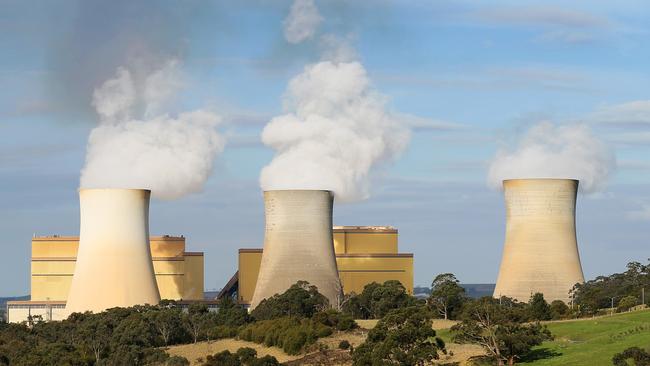AGL will be the last to exit coal-fired power
Origin Energy and EnergyAustralia plan to close coal-fired generation assets years before the 2050 date set by AGL.

AGL Energy will be the last of the nation’s big three power companies to exit coal-fired power under current closure plans, despite the power giant’s advertising campaign highlighting its plans to get out of the fossil fuel.
Origin Energy and EnergyAustralia both say they are planning to close their coal-fired generation assets years before the 2050 date by which AGL has declared it will close what will then be its last coal plant — Loy Yang A in Victoria.
AGL, the nation’s biggest coal-fired power producer, has drawn criticism from the coal industry, and from Queensland National Senator Matt Canavan, who has called the company hypocritical over its advertising campaign.
The campaign highlights a commitment to exit coal and focus on cleaner energy and new technology as its big power plants reach the end of their expected lives over the next 30 years.
The criticism of the campaign centres on the fact AGL makes most of what are strong profits from coal-fired power, after it acquired more than $3 billion of black and brown coal power assets in the past five years. At the same time, AGL chief Andy Vesey is in the firing line from the Turnbull government over the planned 2022 closure date AGL wants to stick to for the Liddell power station in NSW, after the Australian Energy Market Operator this month warned it could lead to a shortfall of dispatchable power availability.
Both Origin and EnergyAustralia have said they do not plan to build any new coal plants and intend to close their existing plants at the end of their scheduled lives, although they have not promoted this as a commitment as AGL has.
Origin owns the Eraring power station in the Hunter Valley, the nation’s biggest power station, which it bought in 2013 from the NSW government.
“Origin has already announced plans to close our only coal-fired power station, Eraring, by the early 2030s at the end of its operational life,” an Origin spokeswoman said yesterday.
EnergyAustralia, the local subsidiary of Hong Kong’s CLP Holdings that is run by Reserve Bank board member Catherine Tanna, plans to be out of coal eight years earlier than AGL.
It runs what is now the nation’s most emissions-intensive coal plant, Yallourn in Victoria, after the closure of the Hazelwood brown coal plant in March.
It also owns the Mount Piper plant in NSW, one of the nation’s newest and most efficient coal plants, which The Australian this week revealed could close early because of coal supply concerns.
An EnergyAustralia spokesman said the Yallourn mine had coal supplies sufficient to run the plant until 2032, but that its mine licence would expire in 2026 and would need to be renewed.
Mount Piper, if coal supply can be secured, has a 50-year life that is scheduled to end in 2042. “As presently advised, we’re working to those dates,” the spokesman said, noting that this could change, depending on policy settings and market developments.
AGL’s ability to profit strongly from the current surge in wholesale prices is due largely to two big coal acquisitions made by Mr Vesey’s predecessor at AGL, Michael Fraser.
In 2012, AGL bought the 67.5 per cent of the Loy Yang A brown coal power plant in Victoria it didn’t already own (and the station’s big debt load), in a transaction that valued the plant at $3.1bn.
In 2014, the company bought the Bayswater and Liddell black coal power plants in the Hunter Valley from the NSW government for $1.5bn. Liddell will reach the end of its life in 2022 and Bayswater in 2035.
AGL yesterday declined to comment on the plans of its rival generator-retailers.
In April this year, the company embarked on an advertising and rebranding campaign, saying it would get out of coal by 2050.
“We are in a unique position as Australia’s largest ASX-listed owner, operator and developer of renewable energy but also the largest emitter of carbon — we recognise we need to show how we are assisting with the energy transition,” Mr Vesey said.
“In 2015 we set a deadline to be out of coal by 2050 because an orderly closure of coal is needed to deliver energy security, reduce price spikes for customers and ensure the lights stay on tomorrow and into the future as we transition to a higher penetration of renewables.”

To join the conversation, please log in. Don't have an account? Register
Join the conversation, you are commenting as Logout